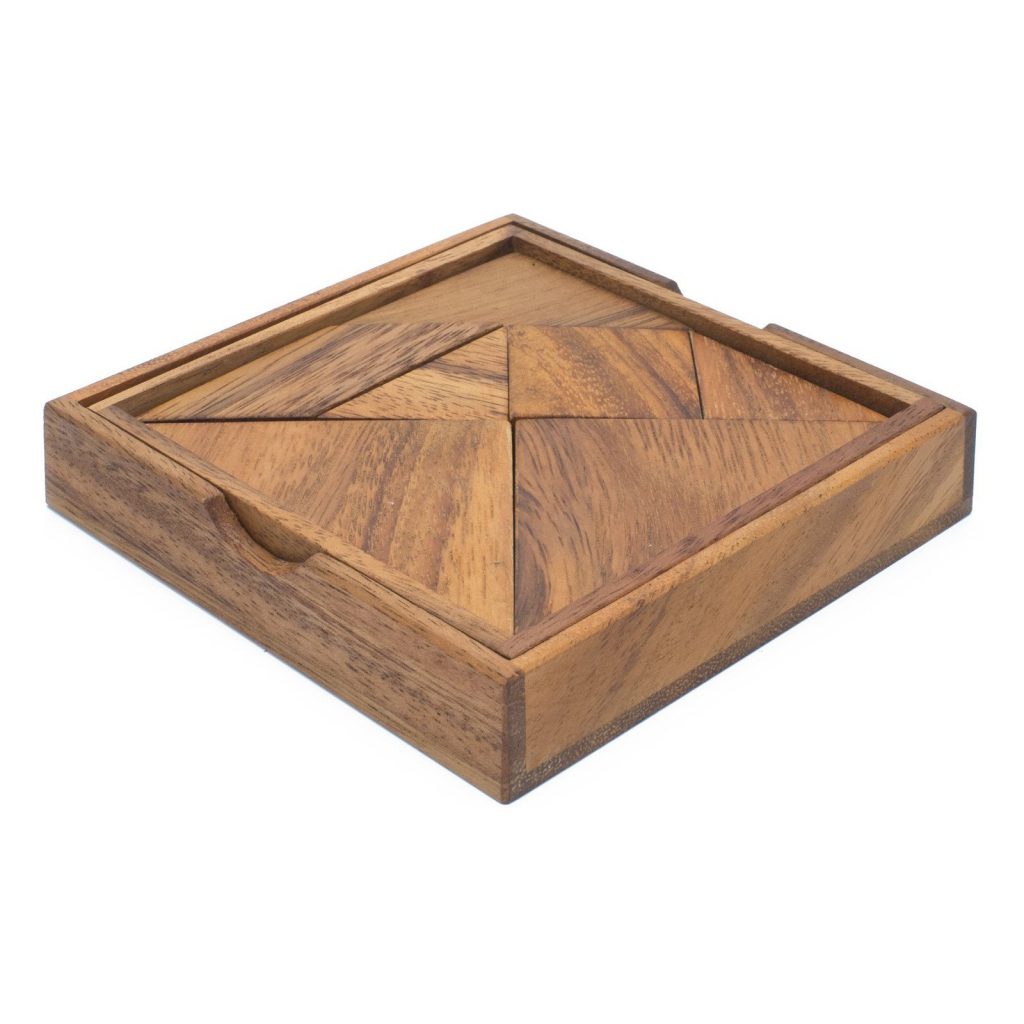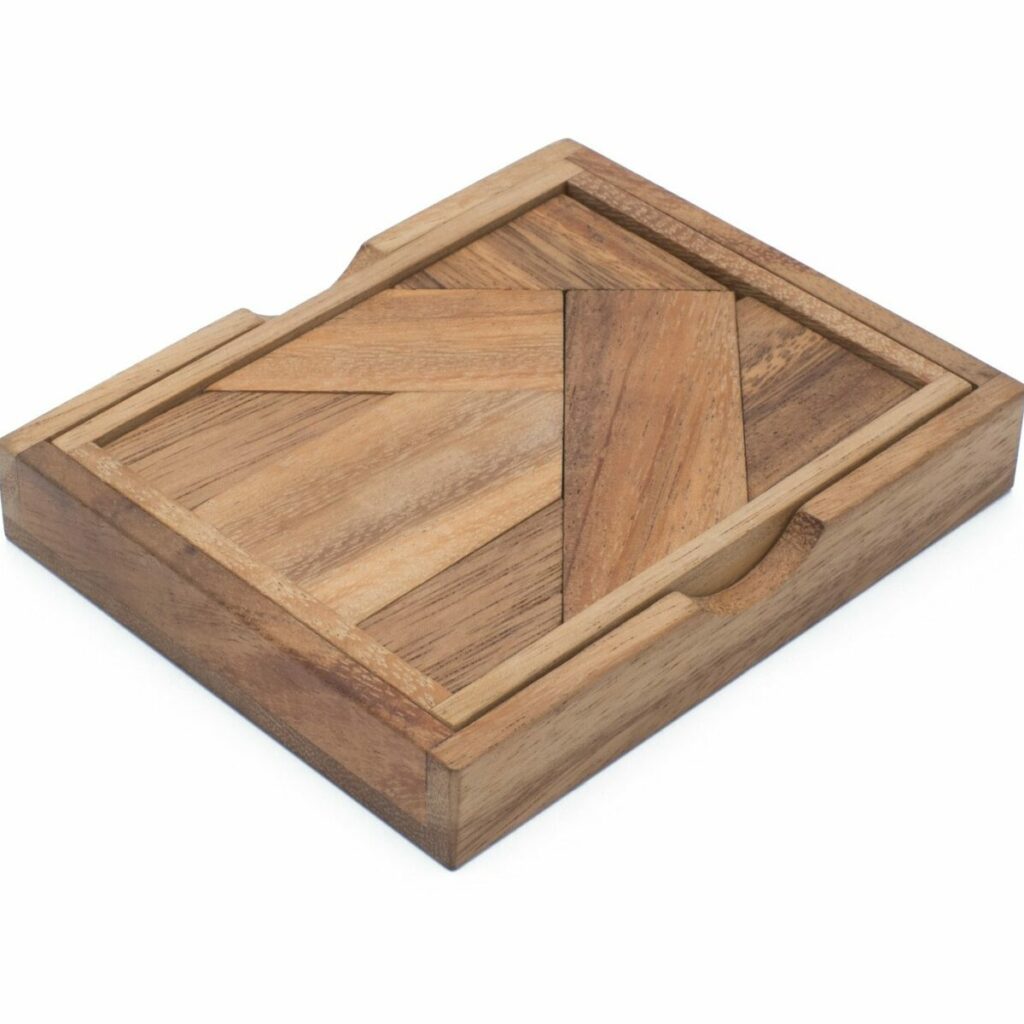
The tangram – translated from its native Chinese where it is literally called the "Seven Boards of Skill". A true classic if ever there was one - and the starting point for many puzzlers. The Tangram is debatably the most famous puzzle of all time. Consisting of 7 flat shapes called ‘tans’ they form together to make a square where no parts overlap.

Tangram
Tangram puzzles – although one of the most popular puzzles and pervasive ever made, its true origins remain obscure: without the exact date of invention, era or even location. Although we are unsure of the definitive history, its modern carnation dates back to ancient Chinese mathematicians.
Although the precise date is not known, It seems probable that Tangrams were formed in China during the Song or Tang Dynasty, although details beyond that are somewhat clouded, experts often venture to estimate the initial date at around the 3rd century.
What is amazing, is that there is no record of Tangrams until the 18th century this fact would lend itself to the idea that the game was considered for women and children only, and therefore not worthy of note in Chinese texts. Puzzle expert, Jerry Slocum, has surmised that Tangrams were probably formulated from the basis of Pythagorean Theorem, Chinese mathematicians would use Tangrams in formulating early equations.

Tangram Paradox
Indeed, the Tangram puzzle – translated from Chinese is literally called the Seven Boards of Skill. A true classic if ever there was one. The Tangram is debatably the most famous puzzle of all time. Consisting of 7 flat shapes called ‘tans’ they form together to make a square where no parts overlap.
It’s astounding considering its popularity today that the first recorded note of Tangrams is in western civilization at around 1820.
One of the beauties of the Tangram is that they are so simple and yet provide a variety of complex solutions – it is estimated that more than 1 billion possible conclusions and over 10 million complete shapes are possible. In the 19th Century alone, there were over 6500 different Tangram problems presented and the number is ever-growing.
From the Tangram there are only thirteen convex Tangram configurations – these are legitimate solutions where a line segment can be drawn between any two points on the configuration's edge always pass through the configuration's interior.
The tans themselves are based on basic geometric principles – each tan can be divided into several component triangles, each one a right isosceles triangle with a hypotenuse equal to √2 units and two side that measure 1 unit.
For example, the small triangles in the set are composed of two base triangles lined up side-by-side. The square is made up of two base triangles joined at the hypotenuse, and so on.
Tangram puzzles have become the most popular dissection puzzle – they were frequently used as early psychological tests. A Chinese psychologist termed the Tangram “The Earliest Psychological Test in the World.” – Albeit one made for entertainment rather analysis.
The Tangram was first brought to America by Captain M. Donnaldson, on his ship, Trader, in 1815. When it docked in Canton, the captain was given a pair of Tangram books by Sang-Hsai-Koi’s – the ship then sailed to Philadelphia, the very first Tangram books release too America were based on the pair brought by Donnaldson.
The puzzle was initially popularized with a revolutionary marketing ploy of a faux history. The Eighth book of Tan, a fictitious history of Tangram, which claimed that the game was invented 4,000 years prior by a god named Tan – the pieces were based upon the sun, the moon and the five planets. This product also included 700 possible configurations to solve. Samuel Loyd, an American puzzle expert, concocted this elaborate story – which was uncovered as a clever hoax.
The puzzle soon reached England, where it became very fashionable, the craze was obviously contagious as it quickly spread to neighboring European countries. This was mostly due to two British Tangram books, the Fashionable Chinese Puzzle, and the accompanying solution book, Key. Soon Tangram exportation became a serious business in China, with an abundance of exotic woods, shells, ivory jade and gemstones forming the base of the most decorative varieties.
Many of these delicate tangram sets made their way to Denmark – where sales exploded in 1818 – and two further books were published the Mandarinen and Det Nye Chinesiske Gaadespil.
In a more international format, the Tangram puzzle saw a resurgence of interest during World War 1 – and was used as a toy on the home front of both trenches. During this time, it occasionally went by the name of “The Sphinx” and re branding of “The Anchor Puzzle” – which was popularized throughout Germany in the early 19th century.

There are numerous interesting stories about the Tangram and their history. We detail one in a previous article: “The History of Tangrams” about the master craftsman who had shattered a glass pane destined for the King. Although this story is glamourous the truth is probably more modest: a particularly interesting tale is of The Tanka people - a river nomad tribe who were great traders of opium. The western sailors they traded with opium to play with the puzzle when they visited their Tanka girlfriends.
Other believe that the beginning of Tangrams is rooted in Yanjitu furniture. This type of furniture is a carefully concocted table of 6 rectangular and 1 triangular table. This triangular piece allowed the tables to be maneuvered into a square table, which later became wooden blocks for playing.
Whatever the source the Tangrams remain a favorite puzzle the world over. A real classic.


